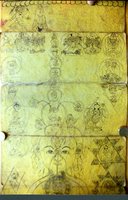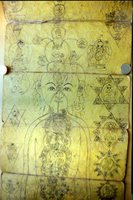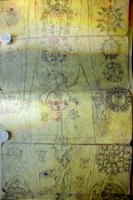 This interesting thyasaphu folding book (leporello) contains two elaborate depictions of the subtle body. I saw it in London with an art dealer and was allowed to make a few photographs for my research (apologies for the poor quality). The first one gives three series of cakras in parallel, including the āvaraṇas of the Śrīcakra ( the series on the right) .
This interesting thyasaphu folding book (leporello) contains two elaborate depictions of the subtle body. I saw it in London with an art dealer and was allowed to make a few photographs for my research (apologies for the poor quality). The first one gives three series of cakras in parallel, including the āvaraṇas of the Śrīcakra ( the series on the right) . This illustration of the subtle body is not particularly early: a very good source to consult for an early systematisation is Netratantra 7 (the text has been recently dated by Alexis Sanderson to around 825 AD. More precisely to between 700 and 850 but with bias to the first quarter of the ninth cent. Appendix on the Provenance and Date of the Netratantra. Religion and the State: "Saiva Officiants in the Territory of the Brahmanical Royal Chaplain with an Indo-Iranian Journal 47 (2004), pp. 229--300.). This occurs in the context of an elaborate teaching of three methods of kālavañcanam (“cheating death”) .
The whole discussion spans three chapters of the text, 6.9–8.54ab. That there are three such methods is affirmed at 8.49–50b:
sarvakālaṃ tu kālasya vañcanaṃ kathitaṃ priye |
evaṃ tu trividhaṃ devi mayā te prakaṭīkṛtam ||
8.50 kālasya vañcanaṃ nāma yogaḥ paramadurlabhaḥ |
anenābhyāsayogena mṛtyujid bhavati naraḥ ||
The three methods of cheating death are thus:
1) sthūla (=mantra ritual 6.9–50),
2) sūkṣma (yogic 7.1–53, the section that teaches the subtle body),
3) para (gnostic 8.1–54ab, =paropāya, =aṣṭāṅgayoga).
 What makes Netratantra 7.1–53 so valuable is the fact that it sets out an already fairly complex syncretic form of the subtle body teaching series of cakras, knots (granthi), voids (vyoman), dhāman (here the three “lights”), channels (nāḍi), winds (pavana), etc. Most significantly, it includes what must be one of the most lucid expositions of the subtle body according to the two prakriyās: the kulaprakriyā and tantraprakriyā. For example, concering the sixteen ādhāras we have the following two divergent lists provided by Kṣemarāja in his unpretentious commentary.
What makes Netratantra 7.1–53 so valuable is the fact that it sets out an already fairly complex syncretic form of the subtle body teaching series of cakras, knots (granthi), voids (vyoman), dhāman (here the three “lights”), channels (nāḍi), winds (pavana), etc. Most significantly, it includes what must be one of the most lucid expositions of the subtle body according to the two prakriyās: the kulaprakriyā and tantraprakriyā. For example, concering the sixteen ādhāras we have the following two divergent lists provided by Kṣemarāja in his unpretentious commentary. A) According to the tantraprakriyā: aṅguṣṭha, gulpha, jānu, meḍhra, pāyu, kanda, nāḍi, jaṭhara, hṛt, kūrmanāḍī, kaṇṭha, tālu, bhrūmadhya, lalāṭa, brahmarandhra, dvādaśānta. These are fairly self-explanatory.
A) According to the tantraprakriyā: aṅguṣṭha, gulpha, jānu, meḍhra, pāyu, kanda, nāḍi, jaṭhara, hṛt, kūrmanāḍī, kaṇṭha, tālu, bhrūmadhya, lalāṭa, brahmarandhra, dvādaśānta. These are fairly self-explanatory.B) According to the kulaprakriyā: kula below penis (meḍhrasyādhaḥ), viṣa in middle of penis (madhye), śākta base of penis (mūle), agni space of four digits above penis, ghaṭa in the fire-center and in the navel (pavanādhare) and below the navel, sarvakāma solar plexus to heart diaphragm (nābhihṛnmadhyamārge), saṃjīvanī in the heart lotus, kūrma chest (vakṣaḥsthala), lola in the mouth (gale), sudhādhāra above the lambhaka (lambhakasya…ūrdhve), saumya at its base (tasya mūlam āśritya), vidyākamala between eyebrows (bhrūmadhye), raudra palate (tālutalādhāra), cintāmaṇi =the crossroads (catuṣpatha), turya in cranial apperture, and as a seventeenth, the nāḍyādhāra (all pervasive).
 I have recently trawled through secondary literature on the subject of the subtle body with some dismay. It is largely based on minuscule selections of texts often irrelevant to subsequent developments; this distorts matters quite unnecessarily. One word of caution (perhaps obvious): research by specialists of Religious Studies is usually unreliable as far as primary sources (especially MSS) are concerned.
I have recently trawled through secondary literature on the subject of the subtle body with some dismay. It is largely based on minuscule selections of texts often irrelevant to subsequent developments; this distorts matters quite unnecessarily. One word of caution (perhaps obvious): research by specialists of Religious Studies is usually unreliable as far as primary sources (especially MSS) are concerned.
No comments:
Post a Comment